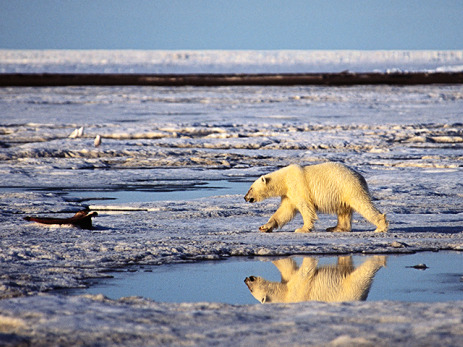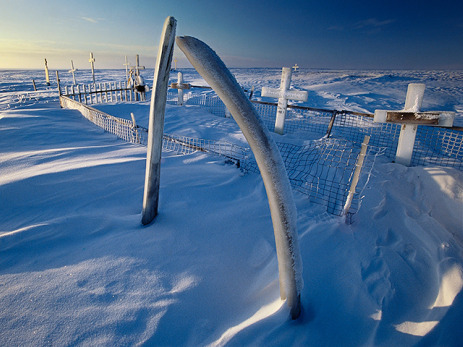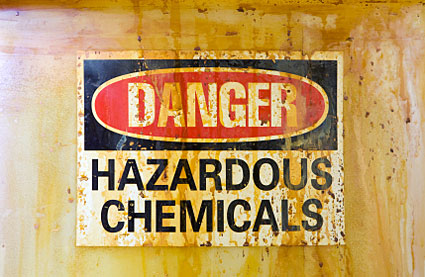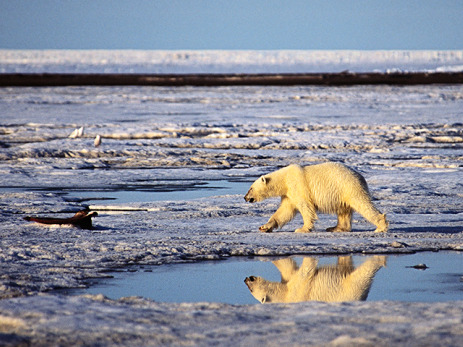This essay was originally published on TomDispatch and is republished here with Tom’s kind permission.
—–
 Polar bear approaching Bowhead remains from a previous year’s hunt, Bernard harbor outside Kaktovik, 2001.Photo: Subhankar BanerjeeBear with me. I’ll get to the oil. But first you have to understand where I’ve been and where you undoubtedly won’t go, but Shell’s drilling rigs surely will — unless someone stops them.
Polar bear approaching Bowhead remains from a previous year’s hunt, Bernard harbor outside Kaktovik, 2001.Photo: Subhankar BanerjeeBear with me. I’ll get to the oil. But first you have to understand where I’ve been and where you undoubtedly won’t go, but Shell’s drilling rigs surely will — unless someone stops them.
Over the last decade, I’ve come to know Arctic Alaska about as intimately as a photographer can. I’ve been there many times, starting with the 14 months I spent back in 2001-2002 crisscrossing the Arctic National Wildlife Refuge — 4,000 miles in all seasons by foot, raft, kayak, and snowmobile, regularly accompanied by Inupiat hunter and conservationist Robert Thompson from Kaktovik, a community of about 300 on the Arctic coast, or with Gwich’in hunters and conservationists Charlie Swaney and Jimmy John from Arctic Village, a community of about 150 residents on the south side of the Brooks Range Mountains.
In the winter of 2002, Robert and I camped for 29 days at the Canning River delta along the Beaufort Sea coast to observe a polar bear den. It’s hard even to describe the world we encountered. Only four calm days out of that near-month. The rest of the time a blizzard blew steadily, its winds reaching a top speed of 65 miles per hour, while the temperature hovered in the minus-40-degree range, bringing the wind-chill factor down to something you’ll never hear on your local weather report: around minus 110 degrees.
If that’s too cold for you, believe me, it was way too cold for someone who grew up in Kolkata, India, even if we did observe the bear and her two cubs playing outside the den.
During the summer months, you probably can’t imagine the difficulty I had sleeping on the Alaskan Arctic tundra. The sun is up 24 hours a day and a cacophony of calls from more than 180 species of birds converging there to nest and rear their young never ceases, day or “night.” Those birds come from all 49 other American states and six continents. And what they conduct in those brief months is a planetary celebration on an unimaginably epic scale, one that connects the Arctic National Wildlife Refuge to just about every other place on Earth.
When you hear the clicking sound of the hooves of the tens of thousands of caribou that also congregate on this great Arctic coastal plain to give birth to their young — some not far from where my tent was set up — you know that you are in a place that is a global resource and does not deserve to be despoiled.
Millions of Americans have come to know the Arctic National Wildlife Refuge, even if at a distance, thanks to the massive media attention it got when the Bush administration indicated that one of its top energy priorities was to open it up to oil and gas development. Thanks to the efforts of environmental organizations, the Gwich’in Steering Committee, and activists from around the country, George W. Bush fortunately failed in his attempt to turn the refuge into an industrial wasteland.
While significant numbers of Americans have indeed come to care for the Arctic Refuge, they know very little about the Alaskan Arctic Ocean regions — the Chukchi Sea and the Beaufort Sea (which the refuge abuts).
I came to know these near-shore coastal areas better years later and discovered what the local Inupiats had known for millennia: these two Arctic seas are verdant ecological habitats for remarkable numbers of marine species, including endangered Bowhead whales and threatened polar bears, Beluga whales, walruses, various kinds of seals, and numerous species of fish and birds, not to mention the vast range of “non-charismatic” marine creatures we can’t see right down to the krill — tiny shrimp-like marine invertebrates — that provide the food that makes much of this life possible.
The Kasegaluk lagoon, which I spent much time documenting as a photographer, along the Chukchi Sea is one of the most important coastal treasures of the entire circumpolar north. It is 125 miles long and only separated from the sea by a thin stretch of barrier islands. Five icy rivers drain into the lagoon, creating a nutrient-rich habitat for a host of species. An estimated 4,000 Beluga whales are known to calve along its southern edge, and more than 2,000 spotted seals use the barrier islands as haul-out places in late summer, while 40,000 Black Brant goose use its northern reaches as feeding grounds in fall.
In July 2006, during a late evening walk, wildlife biologist Robert Suydam and I even spotted a couple of yellow wagtails — not imposing whales, but tiny songbirds. Still, the sight moved me. “Did you know,” I told my companion, “that some of them migrate to the Arctic from my home, India?”
Can oil be cleaned up under Arctic ice?
Unfortunately, as you’ve already guessed, I’m not here just to tell you about the glories — and extremity — of the Alaskan Arctic, which happens to be the most biologically diverse quadrant of the entire circumpolar north. I’m writing this piece because of the oil, because under all that life and beauty in the melting Arctic there’s something our industrial civilization wants, something oil companies have had their eyes on for a long time now.
 Beluga whales with calves along Kasegaluk lagoon, Chukchi Sea coast, 2006. We counted 998 Belugas in about a mile stretch. Photo: Subhankar Banerjee
Beluga whales with calves along Kasegaluk lagoon, Chukchi Sea coast, 2006. We counted 998 Belugas in about a mile stretch. Photo: Subhankar Banerjee
If you’ve been following the increasing ecological devastation unfolding before our collective eyes in the Gulf of Mexico since BP’s rented Deepwater Horizon exploratory drilling rig went up in flames (and then under the waves), then you should know about — and protest — Shell Oil’s plan to begin exploratory oil drilling in the Beaufort and Chukchi Seas this summer.
On March 31, standing in front of an F-18 “Green Hornet” fighter jet and a large American flag at Andrews Air Force Base, President Obama announced a new energy proposal, which would open up vast expanses of America’s coastlines, including the Beaufort and Chukchi Seas, to oil and gas development. Then, on May 13, the United States Ninth Circuit Court of Appeals handed a victory to Shell Oil. It rejected the claims of a group of environmental organizations and Native Inupiat communities that had sued Shell and the Interior Department’s Minerals Management Service (MMS) to stop exploratory oil drilling in the Arctic seas.
Fortunately, Shell still needs air quality permits from the Environmental Protection Agency as well as final authorization from Interior Secretary Ken Salazar before the company can send its 514-foot drilling ship, Frontier Discoverer, north this summer to drill three exploratory wells in the Chukchi Sea and two in the Beaufort Sea. Given what should by now be obvious to all about the dangers of such deep-water drilling, even in far less extreme climates, let’s hope they don’t get either the permits or the authorization.
On May 14, I called Robert Thompson, the current board chair of Resisting Environmental Destruction on Indigenous Lands (REDOIL). “I’m very stressed right now,” he told me. “We’ve been watching the development of BP’s oil spill in the Gulf on television. We’re praying for the animals and people there. We don’t want Shell to be drilling in our Arctic waters this summer.”
As it happened, I was there when, in August 2006, Shell’s first small ship arrived in the Beaufort Sea. Robert’s wife Jane caught it in her binoculars from her living-room window and I photographed it as it was scoping out the sea bottom in a near-shore area just outside Kaktovik. Its job was to prepare the way for a larger seismic ship due later that month.
Since then, Robert has been asking one simple question: If there were a Gulf-like disaster, could spilled oil in the Arctic Ocean actually be cleaned up?
He’s asked it in numerous venues — at Shell’s Annual General Meeting in The Hague in 2008, for instance, and at the Arctic Frontiers Conference in Tromsø, Norway, that same year. At Tromsø, Larry Persily — then associate director of the Washington office of Alaska Governor Sarah Palin, and since December 2009, the federal natural gas pipeline coordinator in the Obama administration — gave a 20-minute talk on the role oil revenue plays in Alaska’s economy.
During the question-and-answer period afterwards, Robert typically asked: “Can oil be cleaned up in the Arctic Ocean? And if you can’t answer yes, or if it can’t be cleaned up, why are you involved in leasing this land? And I’d also like to know if there are any studies on oil toxicity in the Arctic Ocean, and how long will it take for oil there to break down to where it’s not harmful to our marine environment?”
Persily responded: “I think everyone agrees that there is no good way to clean up oil from a spill in broken sea ice. I have not read anyone disagreeing with that statement, so you’re correct on that. As far as why the federal government and the state government want to lease offshore, I’m not prepared to answer that. They’re not my leases, to be real honest with everyone.”
A month after that conference, Shell paid an unprecedented $2.1 billion to the MMS for oil leases in the Chukchi Sea. In October and December 2009, MMS approved Shell’s plan to drill five exploratory wells. In the permit it issued, the MMS concluded that a large spill was “too remote and speculative an occurrence” to warrant analysis, even though the agency acknowledged that such a spill could have devastating consequences in the Arctic Ocean’s icy waters and could be difficult to clean up.
It would be an irony of sorts if the only thing that stood between the Obama administration and an Arctic disaster-in-the-making was BP’s present catastrophe in the Gulf of Mexico.
The first oil rush in Arctic waters
This isn’t the first time that America’s Arctic seas have been exploited for oil. If you want to know more, check out John Bockstoce’s book, Whales, Ice, and Men: The History of Whaling in the Western Arctic. Throughout the latter part of the nineteenth century, commercial whalers regularly ventured into those seas to kill Bowhead whales for whale oil, used as illuminant in lamps and as candle wax. It was also the finest lubricating oil then available for watches, clocks, chronometers, and other machinery. Later, after petroleum was discovered, whale baleen became a useful material for making women’s corsets.
In 1848, when the first New England whaling ship arrived in Alaska, an estimated 30,000 Bowhead whales lived in those Arctic seas. Just two years later, there were 200 American whaling vessels plying those waters and they had already harvested 1,700 Bowheads.
Within 50 years, an estimated 20,000 Bowhead whales had been slaughtered. By 1921, commercial whaling of Bowheads ended as whale oil was no longer needed and the worldwide population of Bowheads had, in any case, declined to about 3,000 — with the very survival of the species in question.
Afterwards, the Bowhead population began to bounce back. Today, more than 10,000 Bowheads and more than 60,000 Beluga whales migrate through the Chukchi and Beaufort Seas. The Bowhead is believed to be perhaps the longest-lived mammal. It is now categorized as “endangered” under the Endangered Species Act of 1973 and receives additional protection under the Marine Mammal Protection Act of 1972. It would, of course, be unforgivably ironic if, having barely outlived the first Arctic oil rush, the species were to fall victim to the second.
Inupiat communities have been hunting Bowheads for more than two millennia for subsistence food. In recent decades, the International Whaling Commission has approved an annual quota of 67 whales for nine Inupiat villages in Alaska. This subsistence harvest is deemed ecologically sustainable and not detrimental to the recovery of the population.
My first experience of a Bowhead hunt in Kaktovik was in September 2001. After the whale was brought ashore, everyone — from infants to elders — gathered around the creature to offer a prayer to the creator, and thank the whale for giving itself up to, and providing needed food for, the community. The muktuk (whale skin and blubber) was then shared among community members in three formal celebrations over the year to come — Thanksgiving, Christmas, and Naluqatuk (a June whaling feast), two of which I attended.
 Inupiat cemetery with Bowhead jawbones, Kaktovik, 2001.Photo: Subhankar BanerjeeIn 2007, with writer Peter Matthiessen I visited Point Hope and Point Lay, two Inupiat communities of about 1,000 inhabitants on the Chukchi Sea coast. Point Hope is considered one of the oldest continuously inhabited settlements in North America. At Point Lay, we accompanied Bill and Marie Tracey on a 17-hour boat ride during a Beluga whale hunt. After the whales were beached, four generations gathered in a circle to offer prayer and thanks to the whales. In other words, for such Alaskan Inupiat communities whales are far more than food on the table. Their cultural and spiritual identity is inextricably linked to the whales and the sea. If Shell’s vessels head north, the question is: How long will these communities survive?
Inupiat cemetery with Bowhead jawbones, Kaktovik, 2001.Photo: Subhankar BanerjeeIn 2007, with writer Peter Matthiessen I visited Point Hope and Point Lay, two Inupiat communities of about 1,000 inhabitants on the Chukchi Sea coast. Point Hope is considered one of the oldest continuously inhabited settlements in North America. At Point Lay, we accompanied Bill and Marie Tracey on a 17-hour boat ride during a Beluga whale hunt. After the whales were beached, four generations gathered in a circle to offer prayer and thanks to the whales. In other words, for such Alaskan Inupiat communities whales are far more than food on the table. Their cultural and spiritual identity is inextricably linked to the whales and the sea. If Shell’s vessels head north, the question is: How long will these communities survive?
And it’s not just whales and the communities that live off them that are at stake. Oil drilling, even at a distance, has already taken a toll in the Arctic. After all, the survival of several Arctic species, including polar bears, walruses, seals, and sea birds, is seriously threatened by the widespread melting of sea ice, the result of climate change (caused, of course, by the use of fossil fuels).
In 2008, the U.S. Department of Interior listed the polar bear as a threatened species under the Endangered Species Act. In addition, millions of birds use the near-shore Arctic waters, barrier islands, coastal lagoons, and river deltas for nesting and rearing their young in spring, and for feeding in summer before they start migrating to their southern wintering grounds. When the Arctic wind blows in one direction, nutrient-rich fresh water from the rivers is pushed out into the ocean; when it blows in the other direction, saltwater from the sea enters the lagoon. This mixing of fresh and saltwater creates a nutrient-rich near-shore ecological habitat for birds, many species of fish, and several species of seals.
All this is my way of saying that if oil drilling begins in the Arctic seas and anything goes wrong, the nature of the disaster in the calving, nesting, and spawning grounds of so many creatures would be hard to grasp.
Don’t let Shell’s drilling ship head north
With the crisis in the Gulf of Mexico ongoing, scientists are beginning to worry about hurricane season. It officially begins on June 1 and doesn’t officially end until November 30. Any significant storm entering the Gulf would, of course, only exacerbate the disaster, moving oil all over the place, while hindering clean-up operations. Now, think about the Arctic Ocean, where blizzards and storms aren’t seasonal events, but an all-year-round reality and — thanks (many scientists believe) to the effects of climate change — their intensity is actually on the rise. Even in summer, they can blow in at 80 miles per hour, bringing any oil spill on the high seas very quickly into ecologically rich coastal areas.
On May 5, Native Village of Point Hope and REDOIL joined 14 environmental organizations in sending a letter to Interior Secretary Salazar. In light of the oil spill in the Gulf of Mexico, it urges him to reconsider his decision to allow Shell to proceed with its drilling plan. That same week, Secretary Salazar did finally order a halt to all new offshore drilling projects and asked Shell to explain how it could improve its ability to prevent a spill — and, if one happens, to respond to it effectively in the Arctic.
On May 18, Shell responded publicly that it would employ a pre-made dome to contain any leaking well and deploy chemical dispersants underwater at the source of any oil leak. From what I gather, both methods have been attempted by BP in the Gulf of Mexico. The dome has so far failed, developing hydrates and becoming unusable before ever being placed over the leak. Scientists now believe that those toxic chemical dispersants have resulted in significant ecological devastation to coral reefs and could be dangerous to other sea life. None of this bodes well for the Arctic.
There is, I’m beginning to realize, another crisis we have to face in the Gulf, the Arctic, and elsewhere: How do we talk about — and show — what we can’t see? Yes, via video, we can see the gushing oil at the source of BP’s well a mile below the surface of the water, and thanks to TV and newspapers we can sometimes see (or read about) oil-slicked dead birds, dead sea turtles, and dead dolphins washing up on coastlines.
But what about all the other aspects of life under water that we can’t see, that won’t simply wash up on some beach, that in terms of our daily lives might as well be on Mars? What’s happening to the incredible diversity of marine life inhabiting that mile-deep water, and what cumulative impact will all that still-spilling oil have on it, on the ecology of the Gulf of Mexico, and possibly — in ways we may not yet be able to imagine — on our lives?
These are questions that desperately need to be asked and answered before we allow oil ships to head north and drilling to spread to America’s Arctic Ocean. Keep in mind that there, unlike in the temperate and tropical oceans where things grow relatively fast, everything grows very slowly. On the other hand, toxins left behind from oil spills will take far longer to break down in the frigid climate. Bad as the Gulf may be, a damaged Arctic will take far more time to heal.
Whatever we can’t see, what we already can see on the front pages of our newspapers and in the TV news should be more than enough to convince us not to take seriously the safety claims of giant oil companies desperate to drill under some of the worst conditions imaginable. Send those drill rigs into Arctic waters and, sooner or later, you know just what you’ll get.
If the remaining permits are approved for Shell in the coming weeks, the Frontier Discoverer will be in the Chukchi Sea less than six weeks later.
President Obama and Secretary Salazar should stop this folly now. It’s important for them to listen to those who really know what’s at stake, the environmental groups and human rights organizations of the indigenous Inupiat communities. It’s time to put a stop to Shell’s drilling plan in America’s Arctic Ocean for this summer — and all the summers to come.



